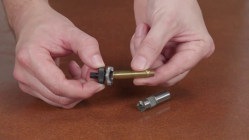My question is this...When annealing cases why do you see some cases start to glow red much sooner than others.I have always thought it might be because some cases had more impurities than others.( heat source staying constant) Am I wrong in my thinking.
This is due to several reasons, but most notably:
1. Neck thickness differences
2. Impurities within the brass
3. contamination on the outer surface of the brass
4. Depending on the method of annealing, the method of holding the brass relative to the flame is a huge factor
5. How full your propane bottle is and how long the setup has been running will effect the energy output
6. If induction annealing, the reliability of the power source and ability to repeatedly position the brass in the coil the same piece after piece.
The ultimate setup for annealing is induction with post testing to confirm achieved hardness. The brass must be aligned in within the coil in the exact same position (both radially and axially) every time. Slight variations of the brass in the coil result in drastically altered workpiece loading on the coil. Technically, brass should be pre-wiped with alcohol prior to annealing. I have to be honest and say that I don’t do this for my own brass but I do take the time to pre-wipe each piece when I anneal for a customer. The magnetic flux within the coil is super consistent from piece to piece assuming the input voltage and current can be closely controlled.
Annealing by flame has so many variable that make it inconsistent at best. Is it better than not annealing? Yes, assuming you closely control the holding of the workpiece in relation to the flame and use a larger propane tank size (20lb tank) that essentially negates the change in thermal output of the flame over each annealing session. Induction is king when it comes to annealing brass both super fast and extremely consistently from piece to piece. A simple test to determine how accurately you are annealing your brass, is to randomly select 5 pieces after annealing (let them fully cool to room temp) and without looking take each piece of brass and use your thumbnail to gently press on the top of the neck with the same force on each piece. Now look at the five pieces when you are done. If the dents are relatively the same on all five pieces, then you are doing a fairly consistent job annealing your brass. Short of testing the hardness after annealing there is no better way to determine the effectiveness of your setup.
Final note, under annealing brass is virtually like having never done anything to it; and contrary to popular belief, it is MUCH harder to ruin brass by “over annealing” it. Easy to have wildly varying hardnesses of brass pieces, but very hard to “ruin” it.
Dave












